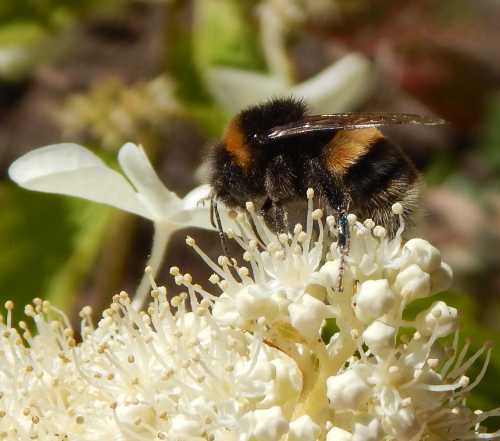Plants For Bees
Here is a list of garden plants and shrubs for bees that
will provide forage for at least one species of bee. Many of these
plants will attract honey bees and different types of bumble bees as well as
solitary bees.
If you are short of space, see my tips about gardening for bees in small spaces.
Most people can accommodate at least a few of these flowers to attract bees and butterflies into their gardens, even if only in pots dotted around the yard.
At
the bottom of this page you'll also find links to further lists of plants
for bees, shrubs, herbs, and more.
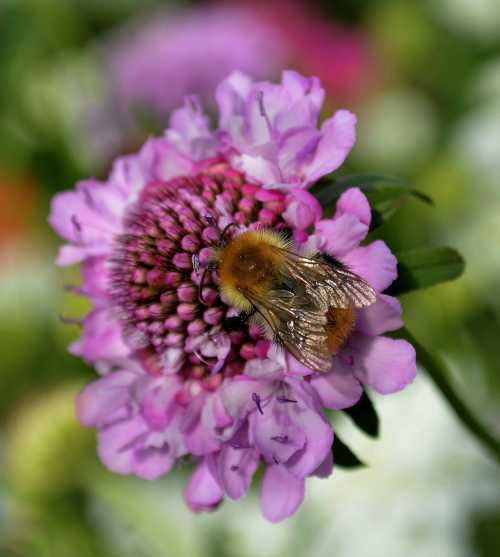 Beautiful bumble bee on Scabious (Pincushion Flower).
Beautiful bumble bee on Scabious (Pincushion Flower).Since first writing this page several years ago, I have also added my page of over 30 Fantastic Garden Flowers For Bees - in alphabetical order, and with more photographs.
The following lists are grouped by seasons:
- LATE WINTER - SPRING GARDEN PLANTS
- SPRING - SUMMER GARDEN PLANTS
- SUMMER – AUTUMN GARDEN PLANTS
- AUTUMN - WINTER GARDEN PLANTS
Please note that flowering season may vary depending on variety and the region in which you live. Check the information on the label.
LATE WINTER - EARLY SPRING GARDEN PLANTS FOR BEES
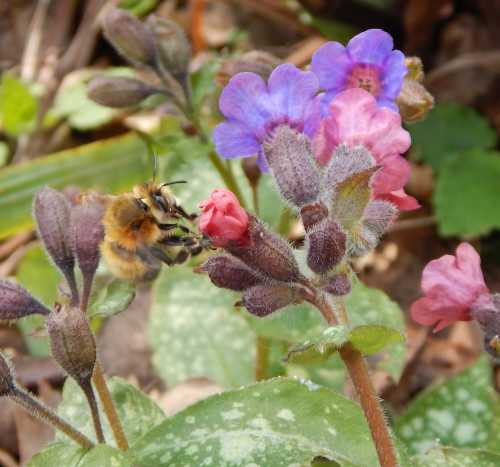 Hairy Footed Flower Bee (male) on Pulmonaria
Hairy Footed Flower Bee (male) on PulmonariaDue to variations in climate and conditions, flowering times may differ from region to region, and this may also affect foraging, as well as the distribution of different bee species. Contrary to popular misconception, honey bees may be seen foraging in cooler temperatures during January and February.
Bumble bees, with their furry coats, may also be found foraging on cooler
days. In fact, bumble bees are increasingly being seen to forage during
the cool winter months in some countries, meaning that late and very early flowering
plants are vital for bumble bees.
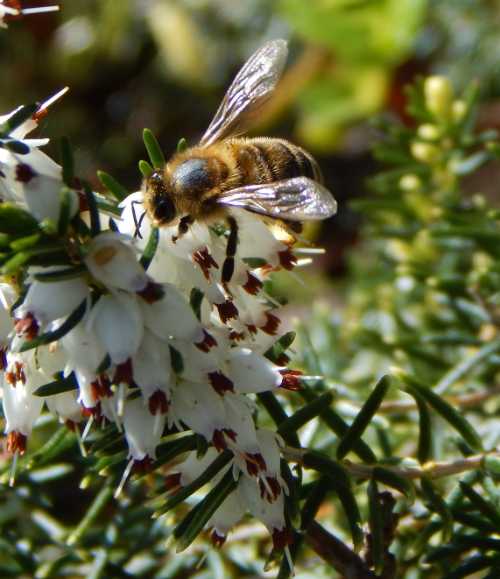 Above: honey bee (Apils mellifera) on winter heather.
Above: honey bee (Apils mellifera) on winter heather.Here is a list of winter / spring flowering plants and shrubs for bees:
Winter Aconite
Crocus
Lenten rose (Helleborus orientalis)
Daffodil (select carefully, e.g. Narcissus pseudonarcissus)
Snowdrops (Galanthes)
Snakeshead (Fritillaria meleagris)
Primrose (Primula vulgaris)
Muscari
Pulmonaria (Lungwort)
Cowslip (Choose native varieties)
Ground Ivy
Daphne bholua
Mahonia
Genista
Sweet box
Dicentra
Gorse (Ulex)
Rosemary (Rosemarinus)
Flowering Currant (Ribes)
Winter Heathers (Erica carnea)
Winter Honeysuckle (Lonicera fragrantissima, Lonicera purpusii)
SPRING - SUMMER GARDEN PLANTS FOR BEES
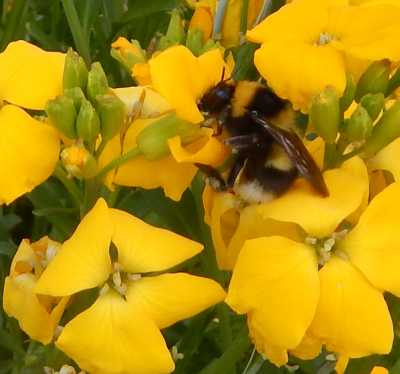 Bumble bees love wallflowers.
Bumble bees love wallflowers.During the Spring and Summer, all types of bees (and other pollinating insects) are rearing their broods.
Plenty of bee friendly plants are therefore vital during the Spring and summer to ensure survival of new generations of bees. Many of these plants will also attract and benefit a range of other pollinators. For example, Milkweed is vital for Monarch butterflies.
Here is a list of spring / summer flowering plants and shrubs for bees:
Poppy
Jacob's Ladder
Foxglove
Bistort
Crane’s-bill (Geranium)
Chives
Bugle (Ajuga)
Borage
Comfrey (Symphytum officinale)
Larkspur (Delphinium)
English Bluebell
Sweetpea (Lathyrus)
Campanula
Lupin / Lupine
Bee balm (Monarda)
Allium
White wild indigo (Baptisia alba)
Sea Holly (Eryngium)
Columbine (Aquilegia)
Salvia
Wallflowers
Cornflower
Phacelia (Scorpion weed)
Sedum (ice plant)
Marsh blazing star (Liatris spicata)
Agapanthus
Butterfly bush (Buddleia)
Honey Suckle (Lonicera)
Cotoneasters
Potentilla / Shrubby Cinquefoil
Caryopteris
Common privet (Ligustrum vulgare)
California lilac (Ceanothus)
Passion Flower (Passiflora)
Thyme
Rosa rugosa
Hebe
Red claws (Escallonia)
SUMMER – AUTUMN GARDEN PLANTS FOR BEES
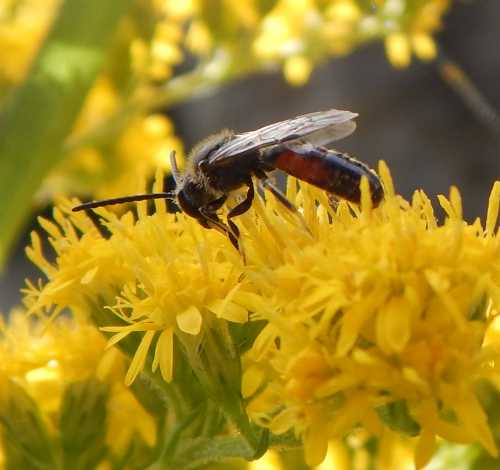 Bloomed furrow bee (male) on Solidago (golden rod). Solidago is popular with a range of solitary bees, bumble bees, and is also visited by honey bees.
Bloomed furrow bee (male) on Solidago (golden rod). Solidago is popular with a range of solitary bees, bumble bees, and is also visited by honey bees.During
the late summer and autumn, these plants will continue to feed late
developing young, as well as those bees that have already developed
into working adults.
Hollyhock
Scorpion Weed (Phacelia)
Dahlia
Purple Loosestrife (note, in some countries this is considered
invasive - please check your region
Sedum
Golden Rod (Solidago)
Cornflower
Verbena
bonariensis
Veronica
Zinnia
Nasturtium
Salvia
Prairie mallow
Verbascum
Scabious (Pincushion Flower)
Sneezeweed
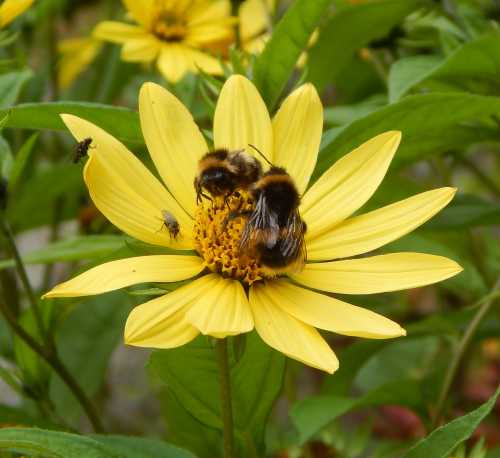 Bumble bees on Helianthus
Bumble bees on HelianthusSunflower (Helianthus)
Watermint
Snapdragon (Antirrhinum)
Lavender
Nepeta (Catmint)
Bugle (Ajuga)
Bergenia
Rudbeckia
Cosmos
Monarda (bee balm)
Erigeron (Fleabane)
Salvia (Sage)
Oregano (Origanum)
Bergamot
Sweet Sultan (Amberboa Muricata)
Japanese anemone
Mint (Mentha)
Echinacea (coneflower)
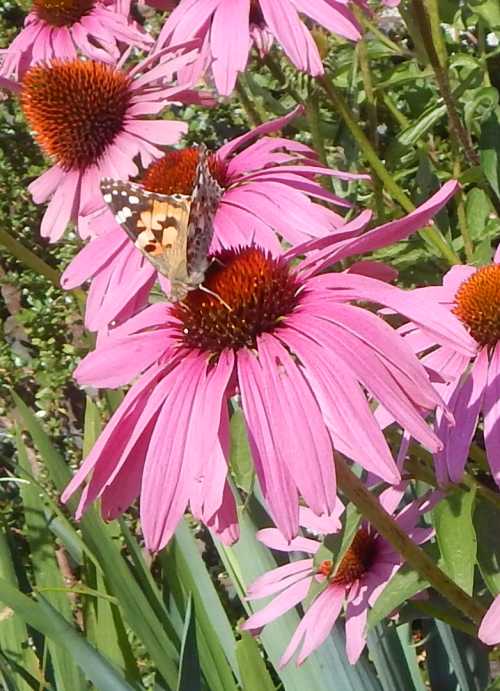 Coneflower - Echinacea are attractive to bees and will also be visited by butterflies.
Coneflower - Echinacea are attractive to bees and will also be visited by butterflies.
AUTUMN - WINTER GARDEN PLANTS FOR BEES
Ivy (hedera helix)
is loathed by some, but it is one of the few plants for bees that aid
survival of the late foragers. In some regions, it is an important source of food for the Ivy Bee, Colletes hederae.
The pollination of ivy then allows berries to develop, thus feeding a number of birds over the winter months, as well as providing excellent shelter. A wall or fence with ivy growing up over it will accommodate more wildlife than without it. Check the plant is not considered invasive in your country before planting.
Late autumn flowering fruits and food crops may also provide a good source of nectar and pollen for bees.
Ivy hedera helix
Autumn raspberries
Viburnum
Common Heather (Calluna vulgaris)
If you found this page helpful or interesting, I'd really be grateful if you would share it with others - if not this page, perhaps another, such as Gardening For Bees.
Thank you so much :) .
